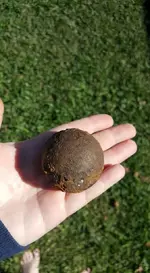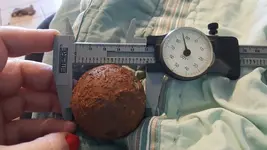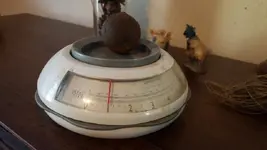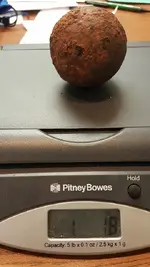You are using an out of date browser. It may not display this or other websites correctly.
You should upgrade or use an alternative browser.
You should upgrade or use an alternative browser.
Please help a newbie identify a cannon ball
- Thread starter mrelder
- Start date
Retired Sarge
Silver Member
- Joined
- Feb 22, 2009
- Messages
- 2,682
- Reaction score
- 5,457
- Golden Thread
- 0
- Location
- Panama City Florida
- 🏆 Honorable Mentions:
- 1
- Primary Interest:
- Other
The cannon ball experts will be around soon....in the meantime what is the precise weight, measurements etc? If the ball is not perfectly round chances of it being a cannon ball are slim. But I'll let the experts figure it out.
Upvote
0
NOLA_Ken
Gold Member
- Joined
- Jan 4, 2011
- Messages
- 5,214
- Reaction score
- 4,179
- Golden Thread
- 0
- Location
- Formerly New Orleans.. Now Pueblo Co
- Detector(s) used
- several, mostly Garrett
- Primary Interest:
- All Treasure Hunting
The measurements and weight are about right for a cannonball from a 1 pounder cannon, CannonballGuy is the go to guy for cannonballs here and should be able to tell you more.
Upvote
0
TheCannonballGuy
Gold Member
- Joined
- Feb 24, 2006
- Messages
- 6,606
- Reaction score
- 13,450
- Golden Thread
- 0
- Location
- Occupied CSA (Richmond VA)
- Detector(s) used
- White's 6000, Nautilus DMC-1, Minelab
- Primary Interest:
- Relic Hunting
Your photos showing the ball's "approximate" weight and diameter measurements are helpful, and I thank you for already providing that info.  As NOLA_Ken said, those preliminary measurements are in the ballpark for a 1-Pounder caliber cannonball. That caliber was used from the Colonial era to the end of the 1830s, when it fell out of favor due to the advent of more-powerful cannons in the run-up to the civil war.
As NOLA_Ken said, those preliminary measurements are in the ballpark for a 1-Pounder caliber cannonball. That caliber was used from the Colonial era to the end of the 1830s, when it fell out of favor due to the advent of more-powerful cannons in the run-up to the civil war.
www.civilwarartillery.com/shottables.htm
Because most 20th-Century "iron" balls are actually made of steel, and no cannonballs made of steel ever got used in America, we need super-precise measurements so we can know with certainty whether your ball is an iron one or a steel one. Unfortunately, spring-type analog scales like the one in your photo are not precisely accurate enough to be trustworthy for authenticating a cannonball. You'll need to use a digital Postal Shipping scale.
The dial-face analog caliper you used is accurate enough for relic authenticating... but we need you to measure two spots on exactly-opposite sides of the ball which have no rust/dirt encrustation on them.
Also, it is helpful to measure the diameter of a "maybe-cannonball" on several directions, to make sure it is a True Sphere... not significantly out-of-round. Being out-of-round could cause a cannonball to jam in the cannon's bore upon loading or firing, so all actual cannonballs were very carefully manufactured and inspected to be perfectly round.
Please do the super-precise measuring with a digital Postal Shipping scale, and re-measure the ball's diameter on some spots that are free of rust/dirt encrustation, and let us know those new measurement numbers.
Meanwhile... here's some reading which you may find to be educational. I co-wrote an instructional article with David Poche on how to correctly distinguish ("authenticate") actual cannonballs from the many imposters... such as mining-&-stonemilling industry rock-crusher balls, gatepost tops, sports shot-put balls, counterweight balls, etc. Go here:
SolidShotEssentialsMod
 As NOLA_Ken said, those preliminary measurements are in the ballpark for a 1-Pounder caliber cannonball. That caliber was used from the Colonial era to the end of the 1830s, when it fell out of favor due to the advent of more-powerful cannons in the run-up to the civil war.
As NOLA_Ken said, those preliminary measurements are in the ballpark for a 1-Pounder caliber cannonball. That caliber was used from the Colonial era to the end of the 1830s, when it fell out of favor due to the advent of more-powerful cannons in the run-up to the civil war. www.civilwarartillery.com/shottables.htm
Because most 20th-Century "iron" balls are actually made of steel, and no cannonballs made of steel ever got used in America, we need super-precise measurements so we can know with certainty whether your ball is an iron one or a steel one. Unfortunately, spring-type analog scales like the one in your photo are not precisely accurate enough to be trustworthy for authenticating a cannonball. You'll need to use a digital Postal Shipping scale.
The dial-face analog caliper you used is accurate enough for relic authenticating... but we need you to measure two spots on exactly-opposite sides of the ball which have no rust/dirt encrustation on them.
Also, it is helpful to measure the diameter of a "maybe-cannonball" on several directions, to make sure it is a True Sphere... not significantly out-of-round. Being out-of-round could cause a cannonball to jam in the cannon's bore upon loading or firing, so all actual cannonballs were very carefully manufactured and inspected to be perfectly round.
Please do the super-precise measuring with a digital Postal Shipping scale, and re-measure the ball's diameter on some spots that are free of rust/dirt encrustation, and let us know those new measurement numbers.
Meanwhile... here's some reading which you may find to be educational. I co-wrote an instructional article with David Poche on how to correctly distinguish ("authenticate") actual cannonballs from the many imposters... such as mining-&-stonemilling industry rock-crusher balls, gatepost tops, sports shot-put balls, counterweight balls, etc. Go here:
SolidShotEssentialsMod
Last edited:
Upvote
0
BIGSCOTT
Hero Member
- Joined
- Jul 19, 2013
- Messages
- 723
- Reaction score
- 703
- Golden Thread
- 0
- Location
- spring texas
- Detector(s) used
- fisher 1265
- Primary Interest:
- Prospecting
The famous twin sisters cannon were hauled threw there and were the only 1 pounders that sam houston had
Upvote
0
TheCannonballGuy
Gold Member
- Joined
- Feb 24, 2006
- Messages
- 6,606
- Reaction score
- 13,450
- Golden Thread
- 0
- Location
- Occupied CSA (Richmond VA)
- Detector(s) used
- White's 6000, Nautilus DMC-1, Minelab
- Primary Interest:
- Relic Hunting
Yes, getting the ball's super-precise weight (1 pound 1.8 ounces) does help. Combining that weight with your photo showing the ball's diameter is 1.987 inches, means the ball is a Steel ball, which excludes it from being a cannonball. Proof: The US Army's Ordnance Manual of 1861 says that a CAST-IRON ball weighing exactly 1.00 pounds will be 1.954 inches in diameter. Your ball, which is only .03" (three one-hundredths of an inch) larger, weighs 1.8 ounces more than it should if it is made of cast-iron. Therefore, your ball is made of Steel, a heavier alloy of iron than simple cast-iron. Steel is approximately 10% heavier than cast iron, and your ball is approximately 10% heavier than the 1-pound ball in the Ordnance Manual's size-&-weight specifications. You can confirm what I'm telling you by reading the 1-pound cannonball info in the first chart and the very last chart, here:
www.civilwarartillery.com/shottables.htm
Please believe me that I get no pleasure at all from having to disappoint a digger than his/her find is not what he/she hoped. May you have good fortune in your future diggings.
www.civilwarartillery.com/shottables.htm
Please believe me that I get no pleasure at all from having to disappoint a digger than his/her find is not what he/she hoped. May you have good fortune in your future diggings.

Upvote
0
Crappies-n-Coins
Bronze Member
Sorry about the disappointment OP. If you have any interest in looking into what it is, look towards steel gage balls that are used by machinists.
Upvote
0
Similar threads
- Replies
- 15
- Views
- 928
- Replies
- 5
- Views
- 538
- Replies
- 4
- Views
- 578
Users who are viewing this thread
Total: 1 (members: 0, guests: 1)







